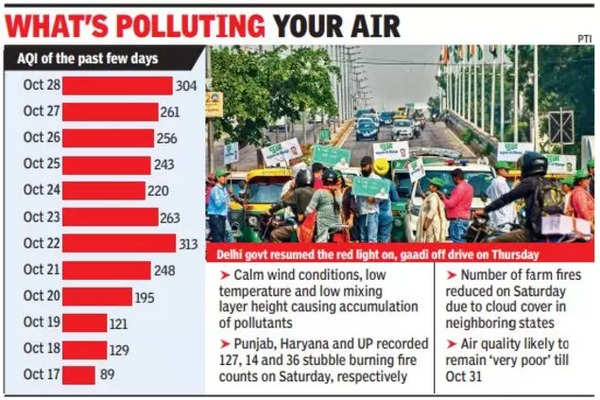In fact, Delhi recorded the coldest night of the season on Saturday with the minimum temperature dropping to 14.3°C, two degrees below normal, at Safdarjung, which is the city’s base station.It was the first time this season when the minimum temperature was below 15°C at Safdarjung. However, the night temperature is likely to remain at 16°C for the next two days.
Track the pollution level in your city
Satellite data compiled by Indian Agricultural Research Institute shows that farm fires have started increasing in states of north-west India.
Most polluted Jahangirpuri in severe zone
The stubble burning count in Punjab stood at 398 on Wednesday, 589 on Thursday and 766 on Friday. However, Punjab, Haryana and Uttar Pradesh reported 127, 14 and 36 instances, respectively, on Saturday. Detection of farm fires on Saturday was hampered by the presence of clouds over Punjab, Haryana and central UP, said IARI, which follows the standard protocol 2021 notified by the Commission for Air Quality Management in NCR and Adjoining Areas (CAQM).
“Calm wind conditions prevailed during the night, which impacted the dispersion of pollutants. Northwesterly winds at a speed of 6-8 kmph blew during the day. Low temperature and a low mixing layer height also slowed down the process of dispersion of pollutants,” said a met official.
Central Pollution Control Board’s data showed that Jahangirpuri was the most polluted station in the city on Saturday as the AQI there reached the “severe” category with a reading of 409. This is the second time this season when the air quality has entered the “very poor” category. On October 22, it had turned “very poor” for the first time this season with an AQI of 313. Measures under Stage II that correspond to this category in the Graded Response Action Plan (GRAP) are already in place.
Anumita Roychowdhury, executive director, research and advocacy, Centre for Science and Environment, told TOI: “The cool and calm conditions of winter are deepening now. High local and regional pollution levels are beginning to get trapped. This is tilting the scale towards the ‘very poor’ category. Implementation of GRAP measures needs to get stronger.”
According to Air Quality Early Warning System, the air quality is likely to be in ‘very poor’ category till October 31. The outlook for the subsequent six days from October 31 is that the air quality is likely to remain in ‘very poor’ to ‘poor’ category. Meanwhile, aiming to tackle vehicular pollution, the “Red Light On, Gaadi Off” campaign was on Saturday being implemented at the Barakhamba intersection.
